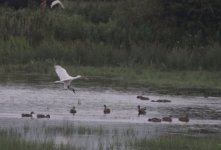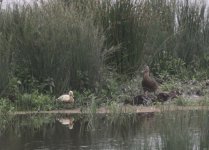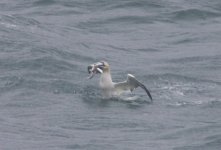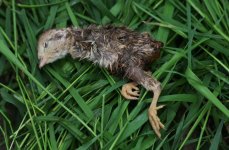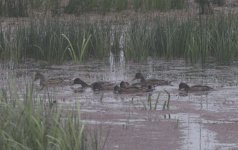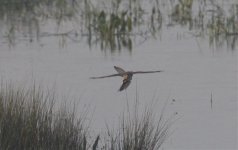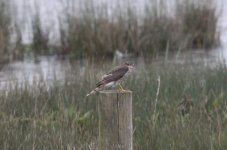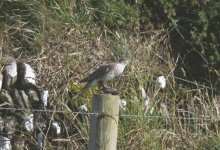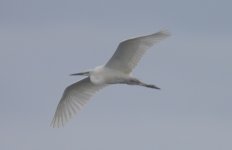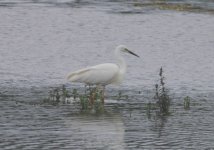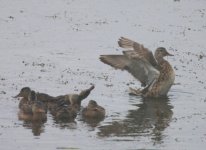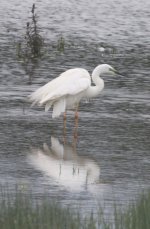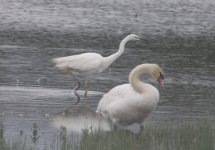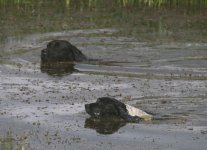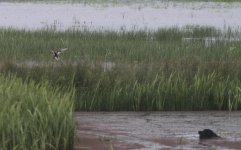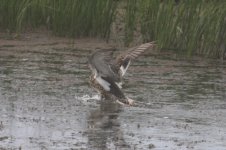-
Welcome to BirdForum, the internet's largest birding community with thousands of members from all over the world. The forums are dedicated to wild birds, birding, binoculars and equipment and all that goes with it.
Please register for an account to take part in the discussions in the forum, post your pictures in the gallery and more.
You are using an out of date browser. It may not display this or other websites correctly.
You should upgrade or use an alternative browser.
You should upgrade or use an alternative browser.
Camel Estuary, Cornwall (1 Viewer)
- Thread starter camelbirder
- Start date
More options
Who Replied?Rumps Point this morning, birds included 50+ Gannet some shallow diving for Sea Bass (photo) 70+ Manx Shearwater, 4 Puffin, Razorbill, Guillemot, Fulmar, Shag, Cormorant, Rock and Meadow Pipit, 6 Linnet including 4 young, several dead chicks on the coastal path, presumed Red-legged Partridge (photo)
Attachments
camelbirder
Well-known member
New species added to the Camel Estuary Birds website including Great Spotted Cuckoo, Belted Kingfisher, Bee-eater, Hoopoe and Wryneck. If anyone has some photographs of Camel Estuary area birds and is willing to allow publication on the website please contact me.
If any errors are noted please also forward.
Best wishes,
If any errors are noted please also forward.
Best wishes,
Sparrow Hawk hunting technique.
This spring at Amble Marshes the bulk passage of hirundines arrived a little later than usual; in most springs it’s the norm to find at least one Merlin hanging around to take full advantage of this annual seasonal influx. This spring was no different, but I was surprised to see on several occasions a tiny adult male Sparrow Hawk (photo with prey) sitting unusually close to a Merlin, then appearing to fly around chasing the Merlin, again unusually close. Later the same tiny male Sparrow Hawk soon perfected the technique of ‘fly-catching Hirundines’ from a convenient perch, its tiny proportions (hardly larger than a Sharp-shinned Hawk) plus it’s amazing agility enabled it to very quickly become extremely successful, so successful that on two occasions I observed the Hawk pluck a Sand Martin from the air and fail to hold on to the injured Martin letting it fall into water, making no attempt to retrieve the struggling bird from the water surface, this just a few yards away from the hunting position, on both occasions preferring to wait for another dry victim to come within range. This feeding bonanza appeared to continued for at least three weeks, with at least two more male Sparrow Hawks (one more adult and a 1st winter (photo) later adopting the Hirundine fly-catching technique, the second adult not quite as successful as the first and the 1st winter only managed one Sand Martin, at least on my limited watch. While it lasted I believe this behaviour accounted for a significant number of migrating Hirundine casualties mostly Sand Martin but also some Barn Swallow, we will never know the true figure though I would estimate the number to be no less than 100 individual casualties, not all of these were consumed, as with Sparrow Hawk attacks in the vicinity of buildings and bird tables a significant number of bird prey are panicked and killed by hitting windows and are not necessarily consumed. Given the apparent association between male Sparrow Hawk and Merlin at the onset of Hirundine migration it’s tempting to make some sort of connection; did the original male observe the Merlin hunting technique and copy it? Did successive male Sparrow Hawks then follow suit? If nothing else this helps to explain the large amount of sexual size dimorphism found in Sparrow Hawk, I’m confident that no normal sized female would be agile enough to be successful at the ‘fly-catching Hirundine technique ‘and perhaps a tiny male would struggle to overcome a Wood Pigeon, just one example of extreme sexual size dimorphism expanding the range of available prey items. A photo of a Sparrow Hawk with more usual prey (young House Sparrow) at Pentire Glaze this Saturday.
This spring at Amble Marshes the bulk passage of hirundines arrived a little later than usual; in most springs it’s the norm to find at least one Merlin hanging around to take full advantage of this annual seasonal influx. This spring was no different, but I was surprised to see on several occasions a tiny adult male Sparrow Hawk (photo with prey) sitting unusually close to a Merlin, then appearing to fly around chasing the Merlin, again unusually close. Later the same tiny male Sparrow Hawk soon perfected the technique of ‘fly-catching Hirundines’ from a convenient perch, its tiny proportions (hardly larger than a Sharp-shinned Hawk) plus it’s amazing agility enabled it to very quickly become extremely successful, so successful that on two occasions I observed the Hawk pluck a Sand Martin from the air and fail to hold on to the injured Martin letting it fall into water, making no attempt to retrieve the struggling bird from the water surface, this just a few yards away from the hunting position, on both occasions preferring to wait for another dry victim to come within range. This feeding bonanza appeared to continued for at least three weeks, with at least two more male Sparrow Hawks (one more adult and a 1st winter (photo) later adopting the Hirundine fly-catching technique, the second adult not quite as successful as the first and the 1st winter only managed one Sand Martin, at least on my limited watch. While it lasted I believe this behaviour accounted for a significant number of migrating Hirundine casualties mostly Sand Martin but also some Barn Swallow, we will never know the true figure though I would estimate the number to be no less than 100 individual casualties, not all of these were consumed, as with Sparrow Hawk attacks in the vicinity of buildings and bird tables a significant number of bird prey are panicked and killed by hitting windows and are not necessarily consumed. Given the apparent association between male Sparrow Hawk and Merlin at the onset of Hirundine migration it’s tempting to make some sort of connection; did the original male observe the Merlin hunting technique and copy it? Did successive male Sparrow Hawks then follow suit? If nothing else this helps to explain the large amount of sexual size dimorphism found in Sparrow Hawk, I’m confident that no normal sized female would be agile enough to be successful at the ‘fly-catching Hirundine technique ‘and perhaps a tiny male would struggle to overcome a Wood Pigeon, just one example of extreme sexual size dimorphism expanding the range of available prey items. A photo of a Sparrow Hawk with more usual prey (young House Sparrow) at Pentire Glaze this Saturday.
Attachments
camelbirder
Well-known member
Great White Egret at Amble Marshes this evening.
Colour ringed Great White Egret at Amble Marshes this evening briefly, left leg orange over green, right leg orange over metal, female Gadwall with 8 ducklings still, 2 lapwing, 1 Curlew, 26 Common Swift and a Stonechat.
Attachments
Jon Turner
Well-known member
Gadwall brood of 8 ducklings still intact at Amble Marshes this morning (photo) now almost full grown. The brilliant single mother has done well, despite the attentions of Peregrine Falcon, numerous Herons, Crows and Foxes.
Glad your Gadwall are flourishing. Went out and looked for the Pochard family here in N Devon yesterday, and discovered 6 fully feathered young with the mother watching over. This may well be the first successful fledging of Pochard in Devon. :t:
camelbirder
Well-known member
camelbirder
Well-known member
Another adult Mediterranean Gull over Wadebridge, flying towards the estuary, at 14.00hrs
Due to any possible doubts over the ring combination/number of rings, I’m posting one more photo showing hopefully, less reflection distortion of the 4 only rings.Colour ringed Great White Egret at Amble Marshes this evening briefly, left leg orange over green, right leg orange over metal, female Gadwall with 8 ducklings still, 2 lapwing, 1 Curlew, 26 Common Swift and a Stonechat.
Attachments
camelbirder
Well-known member
Colour ringed Great White Egret at Amble Marshes this evening briefly, left leg orange over green, right leg orange over metal.
Some interesting ringing details this morning; 'ringed as a nestling 6/5/2009 Besn'e (Loire Atlantique, F) also observed 2-4/7/2011 at ria de Villaviciosa Spain, and from 6-8/6/2012 (at least) at Shapwick Heath NNR Somerset'.
Attachments
Last edited:
Amble Marshes this afternoon.
The hard pressed Gadwall mother certainly had her work cut out this afternoon; the two problem dogs turned up at 13:30 and were still present causing mayhem when I left the site (Amble Marshes) at 17:15. Most of the Waterfowl that could fly off did so, including 2 Green Sandpiper and 6 Eurasian Teal, the two Lapwings put up a fight obviously defending something interesting. For the first 2 hours the female Gadwall did an outstanding job of distracting the dogs from her scattered brood, skilfully managing to fake a wing injury and stay a just few yards ahead of the exited dogs until she eventually tired, then amazingly she dived and swam under water right across the open water to join up with 2 of her frightened brood ( I presume not to risk leading the dogs back to them) This problem could not have started up again at a worse time with the area filled with flightless adults and young vulnerable Waterfowl. My own suspicions are that although flightless duck are the main target for the exited dogs to chase (and I certainly don’t blame the dogs) the real damage is done mostly to the tiny young and eggs of all the near ground nesting birds, you only have to observe the sinister group of Grey Heron (4 today) that always seem to follow the dog commotion, picking up tasty morsels in the dogs wake. On a lighter note the dog activity did flush out a Water Rail that I’m sure I would have struggled to see without them.
The hard pressed Gadwall mother certainly had her work cut out this afternoon; the two problem dogs turned up at 13:30 and were still present causing mayhem when I left the site (Amble Marshes) at 17:15. Most of the Waterfowl that could fly off did so, including 2 Green Sandpiper and 6 Eurasian Teal, the two Lapwings put up a fight obviously defending something interesting. For the first 2 hours the female Gadwall did an outstanding job of distracting the dogs from her scattered brood, skilfully managing to fake a wing injury and stay a just few yards ahead of the exited dogs until she eventually tired, then amazingly she dived and swam under water right across the open water to join up with 2 of her frightened brood ( I presume not to risk leading the dogs back to them) This problem could not have started up again at a worse time with the area filled with flightless adults and young vulnerable Waterfowl. My own suspicions are that although flightless duck are the main target for the exited dogs to chase (and I certainly don’t blame the dogs) the real damage is done mostly to the tiny young and eggs of all the near ground nesting birds, you only have to observe the sinister group of Grey Heron (4 today) that always seem to follow the dog commotion, picking up tasty morsels in the dogs wake. On a lighter note the dog activity did flush out a Water Rail that I’m sure I would have struggled to see without them.
Attachments
camelbirder
Well-known member
Users who are viewing this thread
Total: 2 (members: 0, guests: 2)




